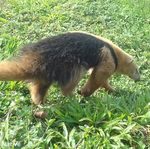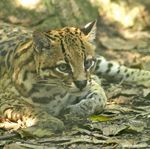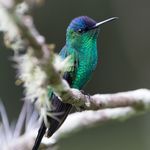SUGAR CANE IN THE ATLANTIC FOREST OF BRAZIL
←
→
Page content transcription
If your browser does not render page correctly, please read the page content below
SUGAR CANE IN THE
ATLANTIC FOREST
OF BRAZIL
A Case Study
This case study is one of many examples of plans and types
of actions that can be taken to reduce negative impacts on
biodiversity or promote positive impacts. UEBT publishes these
cases to inspire companies to take concrete actions in their
own supply chains.
UEBT has drawn the material for this case study from the work
of Native. Native has been a UEBT member since 2012. In 2020,
Native achieved UEBT certification for their ethical sourcing
system. Native has incorporated the requirements from the
UEBT Ethical BioTrade Standard into its systems for sourcing,
including the requirements for Principles 1 and 2 in the UEBT
standard that relate to conservation and sustainable use
of biodiversity.
Native has been promoting regenerative practices for
biodiversity in the production of sugar cane since the 1980s.
SUGAR CANE Saccharum
The Facts
A tall perennial grass that grows well in tropical climates
First domesticated in South East Asia and the Pacific
Cultivation in South America began sometime in the 15thto 16th Century
Most cultivars are hybrids of two or more Saccharum species used for
commercial sugar production
Sugar cane is a cash crop, mostly used to produce sugar and related
products, but also as food for livestock
Ethanol is generally available as a by-product of sugar production
Sugar cane is among the world's largest crops in volume and area
Brazil accounts for almost 40% of the world’s sugar cane
Sugar cane is commonly grown in large-scale monoculture farms
The production cycle includes land preparation, planting, cultivation,
management of the cane stalks and harvesting
Heavy machinery is commonly used in each step
Fertilisers, herbicides, and pesticides are often applied in the preparation
and cultivation phases
Soil conditions are commonly poor, lacking of nutrients and oxygen
Sugar cane is affected by many diverse viruses, sometimes causing
severe production losses
During early growth sugar cane competes with weeds for light,
moisture, and nutrients, and these weeds can impair harvests due
to reduced yields OAL 1 IMPROVE SOIL
G
CONDITIONS
The paradigm shift for Native was not Use organic and natural alternatives to synthetic fertilisers to
improve soil fertility and stability. Mono-cropping degrades soils
an easy challenge. The adoption of
because it reduces soil biodiversity and leads to the overexploitation of
regenerative production techniques did certain soil components. Soil charactersisation is done to identify the
adequate soil biodiversity to repopulate.
not bring immediate results to productivity,
Mucuna pruriens (a tropical legume, seen opposite, below) is used in
costs or income. It takes between two and
crop rotation because it creates a friendly environment below ground to
four years for the bioactivation of living attract biodiversity. Living organisms repopulated in the soil contribute
to form the organic part of the soil and improve its structure. Minerals
organisms to take place and then to actually
are another key component of healthy soils. Re-mineralisation of soils
contribute to the management of the is done through the use of ground rocks and it contributes to form the
inorganic part of the soil. Altogether, this contributes to improve soil
crop (through a regenerative agricultural
nutrients and water retention and to reduce erosion.
model). Understanding and respecting the
Equip vehicles and equipment with high flotation wheels to
timeframe of activating living organisms improve soil respiration. The use of heavy machinery in sugar cane
fields compacts soils and has a negative impact on soil respiration. Soil
is crucial to adjust the techniques to allow
respiration is crucial to sustain plant growth and all biological activity in
the environment to heal the soil. Equipping vehicles and equipment with high flotation wheels
guarantees the integrity of the porous soil spaces and facilitates oxygen
A ION
and show its full
flow and, in turn, the biological process that is crucial for healthy soils.
REGENERT
and productive
potential.
GOAL 2 DECONTAMINATE
THE FIELDS
Implement Integrated Pest Management (IPM) practices to replace
synthetic pesticides that are harmful for the environment. Pests
and diseases are major issues in mono-culture systems, including sugar
cane. Yields and quality is reduced because of the effect of pests and
diseases. Lack of genetic diversity and degraded soil conditions are
among the reasons for the high incidence of pests and diseases in sugar
cane fields. Native eliminated chemical pesticides.
Actions on improving soil conditions (see goal 1) are one component
of IPM in sugar cane fields. They contribute to reduce the incidence of
pests and diseases in the fields. Improved soils lead to a radical change
in the plant physiology of sugar cane, to the point that it builds its tissues
from molecular constituents that fungi, bacteria, and insects have a hard
time digesting. Other actions combat persistent pests through biological
means. Caterpillars eat sugar cane but the wasp Cotesia flavipes is a
food alternative to sugar cane for those caterpillars. Native produces the
wasp in a laboratory and releases it into the fields to attack caterpillars
and distract them from the sugar cane.
Droughts and other climatic anomalies
Extreme weather events such as floods and long periods of
drought have had devastating socio-economic consequences on
people and their livelihoods in the Atlantic forest region of Brazil.
Native has found that agro-ecological management of farms
leads to a change in the physiology of cultivated plants. Plants
under this type of management do not disperse substances
attracting pests and diseases in the air and soil. This leads to an
increase in the resistance of plants to pests and diseases as well
as to the harmful effects of droughts. GOAL 3 CONTRIBUTE TO,
REPOPULATE AND MAINTAIN
LOCAL BIODIVERSITY
Create conditions in the sugar cane fields to meet the main Harmonious coexistence between economic
survival needs of wild felines. Big cats are competing for spaces
activity and biodiversity conservation is
in the habitats surrounding the sugar cane fields. Three things are
crucial for their survival: food, reproduction and shelter. For Native, possible. Commercial culture is just another
the harvest of raw cane leaves many tons of woody, rigid plant
beneficiary of the ecosystem. A production
material in the field every year.
system can only be considered regenerative
This plant material, and the natural fertilizers (organic and ground
rocks) added to it serves as food for the base of the food web, starting if it encompasses and positively addresses
with decomposers. This then generates food for all levels of the food
the needs of the ecosystem in which the farm
chain including for felines and birds of prey that have been captured
on camera in Native’s sugar cane fields. The presence of biocidal in inserted. In other words, the productive
chemicals (see goal 2) does not allow this process to happen.
system (even if oriented to a commercial
goal) must generate positive impacts for
IMPACT the function of the rural ecosystem.
USP – University of São Paulo, Embrapa – Brazilian Agricultural This is measured by monitoring the
Company, Unicamp – University of Campinas, CTC – Copersucar
main indicators of
Technology Center, FGV – Getulio Vargas Foundation, among other
partners, conducted studies for over 20 years in the Native fields of environmental
sugar cane where regenerative practices for biodiversity are followed.
sustainability.
A V ION
OCNSERT
The results of these studies have shown that the results obtained were
significant, in all aspects of sustainability. In terms of the biodiversity
aspects, the findings were:
1,600 monitored movements of higher vertebrate wildlife
in the fields including four species of large cats
200+ species of birds and 500+ species of arthropods
residing in the fields
Soil conditions: bio-structure improvement
Water resources: new streams appearing that had never
occurred before
GHG emissions: carbon ‘drain’ agro-industrial activity
The Atlantic Forest
Most of Brazil’s sugar and ethanol is produced in the southeast
region of Brazil (including in the southern state of São Paulo,
where Native is based in the city of Sertãozinho). This region
was once covered by the Atlantic forest which is comprised of
tropical forests, subtropical grasslands, savannas, shrublands
and mangrove forests.
The Atlantic forest is high in biodiversity and endemic species.
However, more than 85% of the original Atlantic forest has
been deforested, and agriculture is a main source of habitat
fragmentation, including from cattle ranching, sugar cane,
coffee, tea, tobacco and more recently from soybean and
biofuel crops. While deforestation rates have been decreasing
over recent years, conservation and restoration efforts
continue to race against time, with some in the Atlantic Forest
Restoration Pact (PACTO) sharing a goal to recover 15 million
hectares by the year 2050.Regenerative farming is a holistic approach
SUSTAINABLE USE
that re-starts natural functions and
interconnections. Action taken on soils affect
soil fertility, as well as its functions or ecosystem
services. These actions also contribute to
preserving and improving the ground water
levels and to lowering the incidence of pests and
diseases while also increasing
the resilience of sugar
cane to them and to
other stressors.
How can companies begin?
Acting for biodiversity means acting in a systemic and Biodiversity actions take
context-specific way. You can: time. An economic result
such as cost reductions or
Assess opportunities and threats to biodiversity in the context
increased income may not be seen
of your sourcing.
for two to four years, but this does eventually come when living
Implement actions that focus on conservation, restoration, organisms begin to help manage the very farms they are part of.
and sustainable use.
Plan different measures and coordinate with different actors About UEBT and this work
along the supply chain.
UEBT wishes to thank Native, whose work inspired this case.
Native feels that the partnership with an international organisation
Learnings to share
such as UEBT and achieving certification for its ethical sourcing system
Setting biodiversity actions is the first step to promote changes, has been a further motivation to be more specific and detailed in the
but results must also be measured. Developing a partnership with actions taken for people and biodiversity.
reputable local research institutions can help.
‘Results’ also include what knowledge can be built within a Native is the largest world producer of organic sugar and alcohol,
company. This knowledge is necessary to expand the same vision producing 300,000 tons of sugar and 330 million litres of neutral
and technical principles to other farms or sourcing areas, to scale alcohol. Native products include sugars, breakfast cereals, chocolate,
up biodiversity actions to an entire landscape in a way that can also cookies, teas, pastas and more. They also supply organic neutral
contribute to regional conservation and restoration efforts. alcohol to the cosmetics and other sectors.
The UEBT Standard PICTURE REFERENCES: PAGE 1: CLOSE-UP OF SUGAR CANE, SACCHARUM; PAGE 2:
CAMERA TRAP IMAGE OF SOUTHERN TAMANDUA (ANTEATER) TAMANDUA TETRADACTYLA,
UEBT’s Ethical BioTrade Standard – through its requirements HARVESTING RAW SUGAR CANE; PAGE 3: CAMERA TRAP IMAGE OF OCELOT LEOPARDUS
in Principles 1 and 2 (Conservation of Biodiversity / Sustainable PARDALIS, MUCUNA PRURIENS, A TROPICAL LEGUME USED IN CROP ROTATION;
Use of Biodiversity) – guides its members and their suppliers PAGE 4: SUGAR CANE FIELD, VIOLET-CAPPED WOODNYMPH HUMMINGBIRD THALURANIA
to define and implement systemic approaches to biodiversity GLAUCOPIS, ATLANTIC FOREST, BRAZIL. IMAGES PAGE 2 AND 3 COURTESY OF NATIVE.
conservation and sustainable use. To facilitate this process,
UEBT recommends companies adopt Biodiversity Action
Plans as a strategic road map for businesses to contribute
to reversing the loss of biodiversity on Earth.
UNION FOR ETHICAL BIOTRADE
De Ruijterkade 6, 1013 AA, Amsterdam, The Netherlands | Telephone: +31 20 22 34567 | Email: info@uebt.org
Representation in Bélem, Brazil | Ghaziabad, India | Antananarivo, Madagascar | Hanoi, Vietnam
Connect with us www.uebt.org | www.linkedin.com/company/uebt Published March 2021You can also read
























































